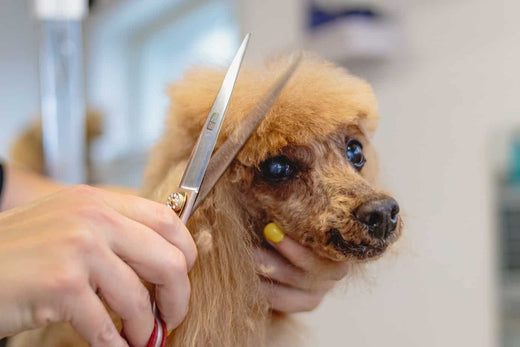
Grooming is an essential part of caring for your pet dog. It keeps their coat strong and healthy, prevents infections, and makes them look and smell amazing. Nowadays, many professional groomers will happily save you the time and effort of doing this task. However, regular grooming sessions can quickly become costly, especially if you have a breed that is high maintenance, such as a Poodle or Komondor. Aside from saving money, grooming your dog at home is an excellent way to strengthen your bond and keep an eye on the condition of their skin and fur. However, if you've never cleaned your dog before, you might feel overwhelmed by the task ahead. While it does require some time, anyone can learn how to groom a dog. So read on for the ultimate guide on dog grooming for beginners.
8 Steps To Grooming Your Dog At Home
There is much more to grooming your dog than a quick brush and an occasional bath. You should include the following eight steps in your at-home dog care regime, although the frequency of each one differs.
Give Them a Bath
Bathing is an essential part of dog grooming as it's the only way to thoroughly clean their skin and fur and remove any foul odors. How often you will need to wash your dog depends on various things, such as their coat type and length, their lifestyle, the time they spend outdoors, and their breed. The best way to tell if your dog needs a bath is by their smell. Some dogs start to get smelly and dirty after one week, whereas others can stay relatively fresh for a month or more. For example, if your dog spends a lot of time outside rolling in mud and splashing in puddles, they will need baths regularly. The same is true for breeds with long drop-coats as their hair collects excess oil and debris. As a general rule of thumb, you should wash your dog no more than weekly but no less than once every three months. For bathing, you will need a shampoo designed especially for dogs. The most effective way to wash a dog is using a shower head or hose, but it's essential to do it slowly and calmly to avoid stressing your pup out. Also, be sure to rinse thoroughly at the end to remove all shampoo residue.
Brush Their Fur
Although you likely won't need to bathe your dog much, you will need to create a regular brushing routine. Fur brushing is an excellent way to remove dirt and keep your pup's gorgeous hair free from matting. Brushing has other benefits, too, such as reducing shedding and allergens. How often you need to brush your dog will depend on their coat type and breed. For example, you should brush a long-haired dog 2 to 3 times a week, whereas once a week is usually sufficient for a short-haired dog. However, suppose you have a dog with a very dense and thick coat, like the American Eskimo. In that case, you might find they require daily brushing. Your pup's coat type will also determine the best tool to use. There are several types of dog hairbrushes and combs available. For example, you should choose a brush with long bristles for long-haired canines or a wire-pin brush if you have a curly-haired dog like the Bichon Frisé. If you want to learn more about the type of coat your fluffy friend has, check out our article dedicated to dog fur.
Give Them a Haircut
Most short-haired canines do not require any hair cutting, but long-hair dogs will need a trim now and again to prevent matting. The specific breed of your pup will determine how often they need a haircut, as the hair of some dogs, such as Poodles and Cocker Spaniels, grows faster than others. Other breeds like Old English sheepdogs grow excess hair on their face. Without regular trimming, it can impact their hygiene and obstruct their vision. Also, consider your pup's age when deciding how often to cut their fur because hair grows faster on young dogs than on older ones. Their lifestyle also plays a role. For example, if your pup spends most of their time outside, it makes sense to keep their coat shorter than if they are indoors most of the day. Then, of course, most dog parents decide to cut their dog's hair for aesthetic reasons, such as to give them a particular style. However, in general, if your dog requires haircuts, you should aim to trim it no more than monthly or bi-monthly.
Take Care of Their Paws
The paw is one body part that you should pay extra attention to when grooming dogs. Dogs spend most of their day on their feet, and their paw pads take frequent impact and handle rough terrains. As a result, dog paws are susceptible to injuries, such as cuts and burns, which can lead to painful infections if untreated. To take care of your pup's precious feet, wipe them with an antibacterial wipe each time they come in from the garden or after a walk. If they are filthy, you might find it easier to wash them instead. Trimming paw hair is also beneficial. If the tufts of hair between the toes get too long, matting can occur, making walking uncomfortable. Your dog paw care routine may also change depending on the season. For example, you should avoid walking your pup during the hottest part of the day in the summer. This is because the hot pavement can burn and blister their paw pads. Then in the winter, you might want to apply dog paw balm to prevent chapping from the cold weather.
Trim Their Nails
While taking care of your dog's feet, you should ensure their nails remain short. Overgrown nails can lead to painful ingrown nails and infection. If your dog spends a lot of time outside, they may not need nail trimming as the rough terrains naturally file them down. However, if your dog is indoors most of the day, you'll likely need to cut their nails occasionally. Once every three to four weeks is usually sufficient. You'll need either a dog nail grinder or a nail clipper specifically designed for canines to trim your pup's nails. A nail grinder can be easier and safer to use, but it does take longer. Clippers allow you to cut the nails quickly, but there is more chance of cutting too deep and causing an injury. Check out our guide on how to trim dog nails if you've never done it before. Regardless of the type of paw your dog has, there are five dog paw parts, all of which serve a specific purpose. So let's dive into each one.
Shop LuckyTail Nail GrindersKeep Their Ears Clean
When grooming a dog, you should also check their ears for issues like mites and clean them if needed. Many breeds are prone to ear infections, so it's good to clean your dog's ears once a month to keep issues at bay. However, if you have a dog with long, floppy ears, like a Beagle or Basset Hound, you can increase the frequency to twice a month as they are more at risk of infection. Before you clean your pup's ears, ensure you have an ear cleaner specifically made for canines and not humans. First, squeeze the ear cleaner directly into your dog's ear, filling the canal. Then massage the base of the ear for 10 to 20 seconds to allow the cleaner to break up any wax and debris. Finally, use cotton wool to wipe away the product.
Brush Their Teeth
Many dog parents do not realize the importance of dog teeth brushing. Without it, our four-legged friends can develop periodontal disease from plaque buildup. Dental issues like periodontal disease can be painful and lead to tooth loss. Therefore, you should brush your dog's teeth at least 1 or 2 times per week, although daily is preferable. You'll need a special toothbrush made for dogs, which you can find at most pet stores. Most have angled handles, which is ideal for larger dogs as they allow you to reach the back teeth. You can also get finger-style toothbrushes that you put over your finger. These are nice for puppies and small dogs. It's also essential that you don't use human toothpaste because they usually contain fluoride, which is toxic to canines if swallowed. So, instead, buy a pet-safe toothpaste that does not contain any harmful ingredients. When brushing your pup's teeth, focus mainly on the back teeth, where most plaque and tartar buildup occurs.
Clean Around the Eyes
You typically only need to clean your dog's eyes if they are visibly unclean or it appears that something is irritating them. It's not uncommon for dogs to get dirt or debris in their eyes from playing outdoors, which can cause them some discomfort. If you notice your dog continuously itching their eyes or you see some dirt, flush them using an eyewash. The best way to do this is to soak a cotton pad in eye cleaner and squeeze it into their eye. Hopefully, this will bring out the debris, which you can then wipe away. You might also notice that your dog has some slight eye discharge. If it is transparent in color and not an excess amount, it's usually no cause for concern. Still, you can wipe it away to prevent crusting. Lastly, if you notice any signs of infection, such as squinting, swelling, or redness, book an appointment with your vet.
Dog Grooming Tips
Here are a few final tips to help you have a successful at-home grooming experience.
1. Create a calm, distraction free environment
Always pick your grooming times carefully. We recommend taking your pup for a long walk to tire them out and bring them into a calm state before the session. Then, ensure nothing can distract your dog, such as people or other pets walking in and out. Removing all distractions is vital during tasks like nail clipping as if something startles them, they could easily get hurt.
2. Familiarize them with the tools first
Before you use any new tool or equipment on your pup, let them see and smell it. For example, if you're brushing your dog's teeth for the first time, let them smell and taste the toothpaste first and introduce them to their toothbrush.
3. Use canine specific products only
Don't use human beauty or hygiene products on your pup. Just because those products are suitable for humans does not mean they are safe for pets. Nowadays, you can easily find grooming products specifically formulated for dogs in any pet store.
4. Feed them a nutritious diet
We groom our dogs to improve their health and wellbeing. However, if they are not eating nutritious and complete dog food, our efforts may be in vain. High-quality dog food is just as important as brushing and bathing for keeping your pup's coat and skin in top condition. Plus, a predominately wet food diet is best for your dog's dental health, as too much kibble can cause dental issues.
Shop LuckyTail Skins & Coat Chews5. Consult a professional if needed
Finally, if there is any grooming task you do not feel comfortable doing yourself, don't hesitate to contact a professional groomer or vet. They can show you how to do it safely and effectively. Furthermore, if you notice any concerning wounds or potential infections while grooming, take them to the vet.
